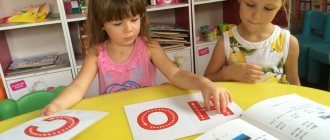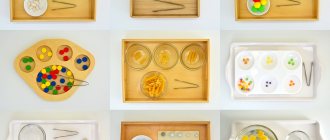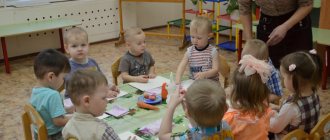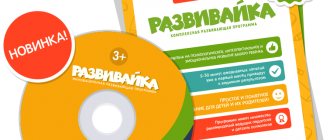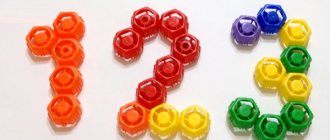Developmental activities for children 3 - 4 years old “The world around us”
Author I. Bushmeleva. Artist N. Gubareva.
At the age of 3-4 years, a child should be able to determine the time of day without difficulty.
Task for a child : Look carefully at the picture and say what the artist mixed up, what he drew incorrectly, why?
A child aged 3-4 years usually already knows that different vehicles are driven by different people. Tell him the name of the professions “machinist”, “tanker”, so that these words will enrich your child’s vocabulary.
Task for the child: Pick a pair. What kind of transport does this or that driver drive?
The child must answer your questions. It is important to present everything in the form of a game.
Assignment (questions) for the child:
1. In the morning the sun rises, and in the evening... (sets)
2. It rained, and... (puddles) appeared on the asphalt
3. Birch has leaves, and pine has... (needles)
4. In winter it often snows white, fluffy... (snow)
5. Water flows from the tap. And when it freezes, it turns into... (ice)
6. Is the ice soft or hard? (solid). Can it flow like water? (No). Is it cold or warm? (cold). Is the water cold or warm? (can be cold and warm).
A 3.5-4 year old child must distinguish animals that can live in city apartments from animals living in the countryside.
Activity with a child: look carefully which of these animals live in the village.
We teach a child to recognize a tree by its leaves. We study the names of flowers.
Task for a child : look at the leaves, from which tree did they fall (birch, maple, willow)? What are these flowers called (chamomile, rose, tulip, cornflower)?
A child of 3-4 years old, of course, already knows wild animals (from fairy tales, pictures, poems). He must be able to describe the animal and tell some of its features.
Activity with a child : There are animals in the picture, name them. Which one of them lives, where does it live, what does it like to eat, what color is its skin, which one is bigger? What are the “legs” of a wolf (paws) called? What about the elephant's nose (trunk)? Which animal has the largest neck, ears, teeth?
A child of 3-4 years old should be able to separate vegetables from fruits and voice the fact that some fruits are vegetables (grow in the garden), and others are fruits (grow on trees).
Assignment for a child: Miraculously, the tree grew fruit. Name them. Look and tell me which fruits do not grow on trees. Where do they grow?
A child aged 3-4 years already knows that there are adults and children. But what are they called correctly?
Activity with a child : Please tell me who is drawn in this picture (animals, beasts)? Please note that these are parents and their children. Do you know what they are called? (elephant (elephant) - baby elephant, bear (shema bear) - bear cub, cat (cat) - kitten, tiger (tigress) - tiger cub).
A 3.5-4 year old child should already know polite words and be able to use them correctly.
Lesson with a child: question - answer. Ask your child to answer your questions.
- In the morning you woke up and went to brush your teeth, on the way you met your mother. What will you tell her? (Good morning).
- In kindergarten, the girl Tanya treated you to an apple, and you told her... (thank you).
- You have friends? What are their names? If your friend asks you to help him, what will you do? (I'll help).
- Do you go to kindergarten? What time of day do you come to kindergarten (in the morning), and when do your parents pick you up (in the evening).
- What do you say to your family when you go to bed (good night).
- You came to visit a friend, what will you say when you see him? (Hi Hello).
- Mom asked you to help her clean the room, what will you do? (I’ll help, collect toys, etc.).
- Grandma was knitting socks for you, and her ball of yarn fell, what will you do? (I'll pick it up).
Development of fine motor skills
It is very important not to miss this moment. Many parents who conduct activities and games for children 3-4 years old at home completely forget about motor skills. But in vain, because this skill is the strongest stimulus for the development of a child’s memory, thinking, speech and attention.
Great activities include:
- fastening, sorting (you can also use ordinary fasteners, buttons, buttons, eyelets);
- laying out drawings or patterns (from pebbles, cereals, shells);
- sandbox games;
- constructors, cubes;
- various lacings;
- finger games (various gestures are performed to the accompaniment of certain children's poems - clapping, clenching, unclenching fists, etc.).
Developing attention while walking.
"Find"
Find where the red car is here? Can you find a birch tree? Where's the yellow bench? And so on. These simple tasks develop the child's attention well. You can start with simple tasks, and gradually complicate the description of the objects you need to find:
“Find the little green leaf”, “find the black bird”, “find the little dog”, etc.
"Guess and find."
Describe to your child an object that is on the playground, but do not name it. Let the child guess what you wished for and find this item. For example:
“Find what I wished for - it’s on this playground, it’s made of wooden boards, people like to sit on it” (bench).
"Stories for attention."
Come up with a simple story for your child to listen to.
The plot could be like this:
A hedgehog went out for a walk. There he met a squirrel and a bunny. They started playing together. Suddenly a wind blew, it swirled everything around, there was a lot of dust, and when the wind died down, it turned out that only a hedgehog and a squirrel remained in the clearing. Guess who was carried away by the wind?
This is just an approximate “story plan”; the real story, of course, will be richer in detail and more interesting. So that the child can clearly remember all the characters in the fairy tale and quickly be able to answer the question “who is missing?” - you need to try to come up with a story so that the names of all the characters (hedgehog, bunny, squirrel) are heard at least 4-5 times (the more, the better). Thanks to this, the child will have time to get used to each of the characters, easily remember them and be able to easily answer the question “Who is missing?”
To begin with, you can come up with a very simple version of a story to develop attention - it will feature only two heroes. Gradually, the number of heroes who need to be remembered can be increased.
Activities and games during summer walks for children 3 years old.
- Seal
Details Author: Nalivaykina Lyudmila Published May 27, 2016
Summer is coming - a time of long walks, gentle sunshine and fresh air. In the summer, staying at home is a real crime - you want to walk as much as possible and enjoy the summer days.
Summer is not a reason to stop working with children. You can also play educational games during a walk in the summer.
Here you will find a selection of educational games and summer activities that can be done outside. Let your motto be “one walk - one educational game” - this pace will not tire either mother or child, and this summer you will not only relax, but also teach your fidget something useful.
Fun math for a walk.
While walking on the street, you can play math games with your child:
— Mom draws small circles on the asphalt (flowers, boats, etc.). Then he asks the child to count how many circles are drawn. When the counting is done, mom draws the required number next to the circles (for example, three circles - draw the number 3).
— Mom draws a number on the asphalt and asks the child to put as many pebbles (flowers, twigs) next to it as the number represents (for example, next to the number 2 we put 2 flowers).
- Another simple and accessible way to teach counting while walking is to count various objects - steps, cars, pebbles, benches, trees, etc.
— While walking in the yard, play shopping with your child . You can sell and buy anything. And pebbles or leaves can serve as money. A spatula costs three rubles, which means we give mom three pebbles for it. And the bucket costs five - try to count out the required number of “coins”.
— We study “more and less.” We place three blades of grass and two pebbles in front of the child. Let the child answer which is more - pebbles or blades of grass.
— For this game you will need small animal figurines (for example, from a Kinder Surprise). A bunny, a bear and a squirrel found three “berries” in the garden (we place three pebbles in front of the child). Are there enough berries to feed all your friends? What if there are two “berries”?
Personal care
Hygiene. For easy access to the sink, we placed a stool and hung a faucet extension. A towel, toilet paper, a basin for dirty clothes - everything is at the child’s level. He uses an adult soap dispenser: he presses with one hand, and places the other palm towards the hole from which soap drips.
During training, I reorganized the storage:
- she laid out combs, elastic bands, beads, bracelets and hairpins in different baskets;
- added teeth cleaning supplies;
- My husband and I hung a lower mirror.
Now if there is silence at home, we understand that the child is in the bathroom.
Dressing yourself. I myself really love order and teach my child to do it. My daughter puts her things back in their place, sometimes we have to remind them or do it together. It is clear that her independence and self-confidence are directly related to the fact that the necessary things are always available.
In the hallway I hung hooks for outerwear and a backpack. Opposite on the shelves in the closet I placed a basket with hats and mittens. Underneath it are stored outdoor toys and a bucket with a sponge and cloth for washing shoes. At the entrance there is a shelf with shoes for the weather, the rest is stored in the nightstand, just like ours.
I organized the wardrobe and hallway areas during the course for children under 3 years old, now I’ve just made small changes to make it even more convenient for my daughter. For example, I added the Trugen stool from Ikea. Dressing on it is clearly better than just on the floor or on an adult sofa, where your feet don’t reach the floor. True, now my daughter also uses it as a ladder to climb onto the sofa.
Children's clothes are stored on hangers and in the chest of drawers. I tried to place things so that they were as visible as possible. The chest of drawers is divided into sections to make it easy to maintain order.
Sensory
It makes me happy when I hit a point of interest and the child gets carried away for a long time and tries something. So recently I noticed her craving for construction, and we purchased a magnetic construction set. I spent the whole day building it and couldn’t tear it away.
Developmental activities with sensory materials are very useful from the age of 3 years. They influence fine motor skills and indirectly prepare for writing and mathematics, as well as geometry and creativity. I made several sets with my own hands.
Noise cylinders. I made sound bottles from packages from Imunele - I simply poured beans, buckwheat and semolina into them. It is better to take cereals of different sizes.
Mysterious bag. You need to put objects of different shapes or textures into an opaque bag. The older the child, the less different they should feel to the touch. To complicate the game, you can add a second bag with the same contents. Ask them to find the same objects with different hands.
Paired color cards. A game-exercise on knowledge of colors and all shades. It starts with three basic colors and gradually increases in complexity to seven shades of each color: from the brightest to the palest. I want to get cards from the paint store so I can line up the colors.
We also arrange the chocolate egg fixies according to height. Or while walking in the forest we look for thick and thin trunks.
We have 2 rooms in our apartment: a kitchen-living room and a bedroom. In the living room there is a separate children's bookcase and a shelf for books. I change the materials from time to time, so this is once a creativity zone, once a music and sensory zone, but a set for caring for plants and a jug of water are always in their place. Nearby there is a workplace consisting of a table with a chair and a shelf for books.
Interests of three-year-old children
The main feature of a three-year-old baby is his increasing independence, but this should not frighten parents. If earlier he needed the help of adults, at three years old the child tries to do everything on his own, and you should not interfere with him in this. If you start to take care of your son or daughter, most likely they will grow up to be weak and insecure people. Therefore, to the best of our ability, it is necessary to encourage such a desire for self-expression, and not to crush it with the authority of a senior.
In addition, you can look at this with different eyes - by occasionally checking what the precious child is doing, dad and mom can allow themselves to rest or go about their business. The main thing is to guide the child in the right direction, to captivate him with something interesting.
The life of a three-year-old child still follows a certain schedule, and this should be so that he feels comfortable. Based on the fact that walking takes about four hours, the child spends most of the day at home, where his main activity is games, through which he continues his cognitive activity.
Despite the fact that the three-year-old already confidently walks and even runs, he spends most of his time on the floor, where he can play role-playing games, cars, or do creative work. This is quite normal, and it is not at all necessary to force him to sit at the table or on the sofa in order for him to do his business there. It is important that he feels free, both physically and mentally.
